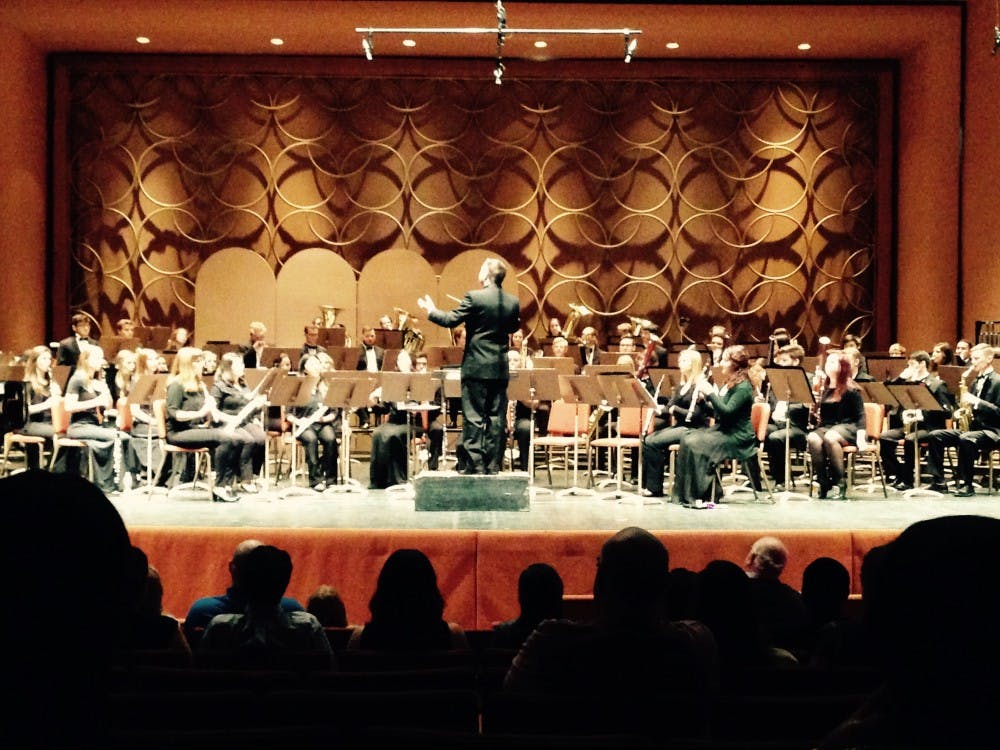Last night, the ASU Wind Ensemble and ASU Wind Orchestra re-defined throwback Thursday with their elegant “Roaring 20s and The Rousing 2000s” performance at Gammage in Tempe.
With the help of some of the most talented conductors and pianists, ASU musicians brought life to the party. This year marks ASU Band’s 100th year of existence, and it is a cause for celebration.
The Wind Ensemble kicked off the show with a dynamic performance of, “An Original Suite,” written by English composer Gordon Jacob in 1928. It sounded like the ultimate triumph song in background of an Oscar-winning film, as Jason Caslor, the recently appointed Associate Director of Bands and Orchestras at ASU in 2015, led as conductor.
#ASUWindEnsemble opening up the concert with "An Original Suite" pic.twitter.com/c4dpoP55Gs
— Kayla King-Sumner (@kaylakingsumner) October 9, 2015
Caslor continued conducting the Wind Ensemble for its second composition, appropriately titled “October.” This piece fast-forwarded to the year 2000, when it was released, to reflect on the current season. The piece was written by Grammy-winning American composer, Eric Whitacre, who was, according to him inspired by, “the crisp autumn air and the subtle change in light.”
Here in Arizona, we’re still waiting patiently for that dream to come true, but the Wind Ensemble excelled in capturing the autumn essence.
This track is named after the best month of the year #October #ASUWindEnsemble pic.twitter.com/90Wdi3D9mQ
— Kayla King-Sumner (@kaylakingsumner) October 9, 2015
The Wind Ensemble switched conductors for the final two pieces. Dr. Caslor handed the baton to Bryan Raya, who is currently a doctoral student at ASU, and is on staff with the one-and-only Sun Devils Marching Band.
The first song conducted by Raya, “Battling Boggarts,” featured the most phenomenal clarinet soloists, Jeremy Ruth and Kristi Hanno. The fast-paced modern track, released in 2011, kept the audience on the edge of their seats the entire time, as the music seemed like it was moving quicker than the musicians’ fingers. The clarinet soloists surely put Squidward Tentacles to shame.
Jeremy Ruth and Kristi Hanno slayin the clarinet pic.twitter.com/Jx2HJ8EMOx
— Kayla King-Sumner (@kaylakingsumner) October 9, 2015
The Wind Ensemble went out with a bang, performing “Give Us This Day,” released by American composer David Maslanka in 2006. The composition is divided into two movements: moderately slow and very fast. The piece, which lasted nearly twenty minutes, took the audience on a wild journey from a smooth-cruise to an ultra-thrilling high-speed chase.
Now THAT is how you finish a song! #GiveUsThisDay #ASUWindEnsemble pic.twitter.com/ggZaM6swzp
— Kayla King-Sumner (@kaylakingsumner) October 9, 2015
Following the Wind Ensemble, the Wind Orchestra performed three pieces. The conductor of all three melodies, Gary W. Hill, is a Professor of Music, and the Director of Ensembles at ASU. Hill was one the highlights of the show with his insanely animated conducting style. Upon each note, he forcefully threw his hands from high to low, and pushed the orchestra to keep up with the tempos.
First, the Wind Orchestra performed a classic cheery march entitled, “Forshay Tower (Washington Memorial March).” This march was originally composed by the renowned king of marching band music, John Philip Sousa in 1929.
The march was once known as Sousa’s “Mystery March” for almost 60 years because he had not been paid a commission for the piece, and his family refused to release it after he passed away. In 1988, a dedicated group of dedicated Minneapolis citizens got together and raised enough money to pay off the debt, and the song could finally be heard by the masses. Last night, everyone in the audience got to taste a little bit of that history.
#ASUWindOrchestra Super awesome performance of John Philip Sousa's Forshay Tower #march pic.twitter.com/LRkbLyE2Ks
— Kayla King-Sumner (@kaylakingsumner) October 9, 2015
The second Wind Orchestra arrangement, “Concerto for Piano and Wind Instruments,” was written by Russian composer, pianist and conductor, Igor Stravinsky in 1923. Stravinsky is widely recognized as one of the most influential composers of the 20th century. As the title implies, the Wind Orchestra and a solo piano take the spotlight.
The solo pianist, Andrew Campbell is an Associate Professor and Director of the Collaborative Piano Program at ASU.The piece contains some of the most exhilarating piano melodies and Campbell is a true match for the challenge. The audience was hypnotized by the endless intensity. Campbell has already established himself as one of the most well-rounded collaborative pianists in the U.S., and he complemented the Wind Orchestra perfectly.
Watch John Campbell KILL IT on piano.. Woah #ASUWindOrchestra pic.twitter.com/AmKhivlcPl
— Kayla King-Sumner (@kaylakingsumner) October 9, 2015
The Orchestra closed the show with “Bells for Stokowski,” released by popular American composer Michael Daugherty in 2001. This whirlwind work highlights each section of the Wind Orchestra and allows them to show off what they’ve got. Let’s just say, they offered everything they had and even more when the piece seemed like it would slow down.
"Bells for Stokowski" #ASUWindOrchestra pic.twitter.com/c7f4zPvgeE
— Kayla King-Sumner (@kaylakingsumner) October 9, 2015
Both the ASU Wind Ensemble and Orchestra brought the house down, and left the audience in amazement. Each member of the ensembles showcased why we should be proud to be Sun Devils. The people onstage are not just any random musicians. These are our classmates, our peers, our friends, and they’re undoubtedly some of the most hard-working and talented college instrumentalists of today.
Reach the reporter at kkingsum@asu.edu or follow @kaylakingsumner on Twitter.
Like The State Press on Facebook and follow @statepress on Twitter.




